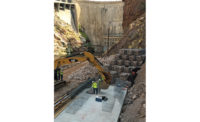Saturation divers, working one at a time, are nearing the end of a repair project on a pumped-storage hydroelectric system at Horse Mesa Dam on the Salt River in central Arizona. The repair will reestablish 97 megawatts of peak-load generating capacity that was lost 13 months ago, when failure of a guide vane sent about 50 tons of concrete shooting down the penstock serving the turbines.
“It is our largest hydro-generation asset on the Salt River,” says Roger Baker, principal engineer for hydro-generation at the U. S. Bureau of Reclamation’s Salt River Project, which owns and maintains the facility. He says getting it back into service is “critical.”
Baker says the incident occurred at the remote dam, about 65 miles northeast of Phoenix, just as the turbines were powering up to support rising midday demand. Operators heard a series of loud bangs and immediately shut down the system.
Investigation showed a large piece of debris had passed through the steel penstock and come to rest in the turbine scroll. Fortunately, the dam itself was unharmed. Crews hauled the material out by hand through a 34-in.-dia access door.
“The operators described it as a dump truck load of rocks coming down the penstock,” says Baker. “The cause is still under investigation.”
Horse Mesa Dam was completed in 1927 and served as a conventional water storage and 32 megawatt hydroelectric generation facility until 1972 when the 97 megawatt “pumpback” system was built by Bechtel. Such systems use electricity available during non-peak times to pump water back into the Apache Lake reservoir so that it can be used during peak-load periods. The 1972 addition was completed by conventional construction crews after the lake was drained to a level sufficient for crews to complete the work.
To complete the repair, however, it was not feasible to drain the lake in order to make the repairs. Public relations-wise, it is an issue for those that work and play on the lake. Environmentally, just pumping the water down river is unfeasible in the arid west. Draining the 245,138 acre-ft Apache Lake slowly might have saved the water, but it would have been a bigger impact on those who own the marinas, restaurants or use the lake as their favorite fishing spot.
“It is our largest hydro-generation asset on the Salt River and getting it back in service was a critical piece to this puzzle,” Baker said.
Baker says after a multitude of studies and research, it was decided that repair would would be best suited to saturation divers — crews that are kept at pressures equal to being underwater in order to eliminate daily decompression routines.
“When we went to bid, we never said, ‘Thou shall sat dive.’ That was up to the contractor,” Baker said.








Post a comment to this article
Report Abusive Comment